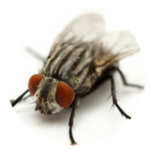 Now is the time of year when adult cluster flies start to enter structures and the time for treating the exterior of buildings to help prevent inward migrations.
Now is the time of year when adult cluster flies start to enter structures and the time for treating the exterior of buildings to help prevent inward migrations.
Cluster flies tend to be more of a problem following a wet summer and many areas in the U.S. have experienced a wet summer. We predict higher populations of cluster flies this year.
The consequences of cluster flies in buildings can range from a nuisance to more serious issues when these pests are found in hospital operating rooms or processing areas of a food plant. They enter the structure as adults in search of a warm site to spend the winter. Essentially, a building wall void is to a cluster fly as the state of Florida is to a snowbird. They more commonly enter structures on the sunny side of the building in fall and are attracted to areas of contrast where dark and light structural elements meet. They do not feed or breed in structures. The adults may emerge from void spaces throughout the winter and spring. Warm, sunny days during the winter can trigger emergence.
Cluster Fly Identification
Adult cluster flies are a little bit larger than the common house fly. They are more sluggish and are often seen near lights and on window sills. They have golden hairs on the thorax, or area behind the head, and lack the pale yellow spots on the abdomen that house flies have.
Biology of Cluster Flies
Cluster fly larvae are parasitic on earthworms and will be found in the ground. The adult female cluster fly lays her eggs on the soil, the larva emerge and seek an earthworm meal. There can 3 -4 generations per year depending on geographical location.
How to Control Cluster Flies
Targeting the exterior areas of the structure where cluster flies are entering is the main strategy once autumn has arrived. If the window for the treatment time is missed and the flies enter the structure, insect light traps placed in false ceilings and attics can offer some relief. During the spring and summer months, focus on excluding the flies by sealing the exterior openings where these flies can enter.
